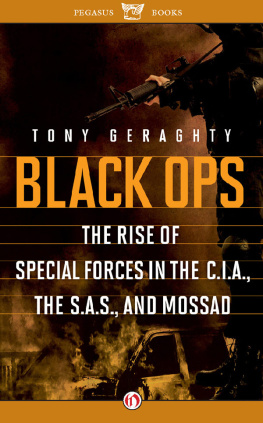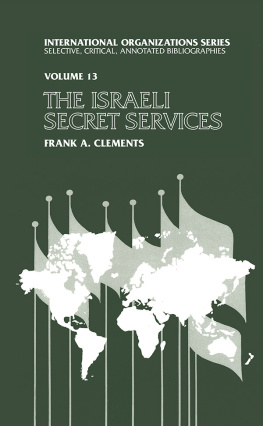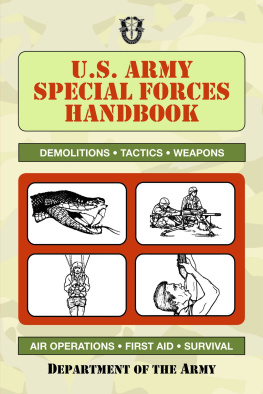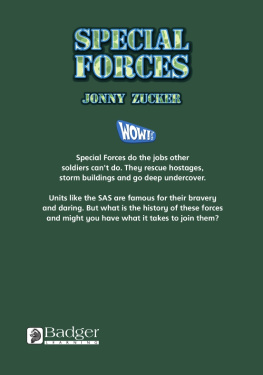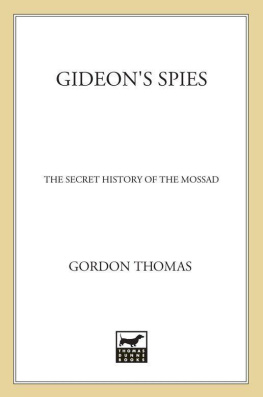Tony Geraghty - Black Ops: The Rise of Special Forces in the C.I.A., the S.A.S., and Mossad
Here you can read online Tony Geraghty - Black Ops: The Rise of Special Forces in the C.I.A., the S.A.S., and Mossad full text of the book (entire story) in english for free. Download pdf and epub, get meaning, cover and reviews about this ebook. year: 2011, publisher: Pegasus Books, genre: History. Description of the work, (preface) as well as reviews are available. Best literature library LitArk.com created for fans of good reading and offers a wide selection of genres:
Romance novel
Science fiction
Adventure
Detective
Science
History
Home and family
Prose
Art
Politics
Computer
Non-fiction
Religion
Business
Children
Humor
Choose a favorite category and find really read worthwhile books. Enjoy immersion in the world of imagination, feel the emotions of the characters or learn something new for yourself, make an fascinating discovery.
- Book:Black Ops: The Rise of Special Forces in the C.I.A., the S.A.S., and Mossad
- Author:
- Publisher:Pegasus Books
- Genre:
- Year:2011
- Rating:4 / 5
- Favourites:Add to favourites
- Your mark:
- 80
- 1
- 2
- 3
- 4
- 5
Black Ops: The Rise of Special Forces in the C.I.A., the S.A.S., and Mossad: summary, description and annotation
We offer to read an annotation, description, summary or preface (depends on what the author of the book "Black Ops: The Rise of Special Forces in the C.I.A., the S.A.S., and Mossad" wrote himself). If you haven't found the necessary information about the book — write in the comments, we will try to find it.
Tony Geraghty: author's other books
Who wrote Black Ops: The Rise of Special Forces in the C.I.A., the S.A.S., and Mossad? Find out the surname, the name of the author of the book and a list of all author's works by series.
Black Ops: The Rise of Special Forces in the C.I.A., the S.A.S., and Mossad — read online for free the complete book (whole text) full work
Below is the text of the book, divided by pages. System saving the place of the last page read, allows you to conveniently read the book "Black Ops: The Rise of Special Forces in the C.I.A., the S.A.S., and Mossad" online for free, without having to search again every time where you left off. Put a bookmark, and you can go to the page where you finished reading at any time.
Font size:
Interval:
Bookmark:
BLACK OPS
BLACK OPS
THE RISE OF SPECIAL FORCES IN THE C.I.A., THE S.A.S., AND MOSSAD

PEGASUS BOOKS
NEW YORK
All rights reserved under International and Pan-American Copyright Conventions. By payment of the required fees, you have been granted the non-exclusive, non-transferable right to access and read the text of this ebook onscreen. No part of this text may be reproduced, transmitted, downloaded, decompiled, reverse engineered, or stored in or introduced into any information storage and retrieval system, in any form or by any means, whether electronic or mechanical, now known or hereinafter invented, without the express written permission of the publisher.
Copyright 2010 by Tony Geraghty
ISBN: 978-1-4532-1827-3
Pegasus Books LLC
80 Broad Street, 5th Floor
New York, NY 10004
This 2011 edition distributed by Open Road Integrated Media
180 Varick Street
New York, NY 10014
www.openroadmedia.com

T he structure of this history of Special Operations Forces reflects an attempt to impose coherence on an idiosyncratic culture. A historical overview in the Introduction describes the various origins of modern Special Forces, notably the British influence on Americas emerging SF teams during and after the Second World War. The major part of the narrative that follows is largely an American story. If it were a fairy tale, it would be Cinderella as told by the Brothers Grimm, with black edges, explaining how Cinderella became the Princess in response to the changing face of armed conflict. The role of the British SAS and Israels multifarious SF teams including Isayeret Matkal, Zionisms SAS, round off the story toward the end of the book.
In practice, the chapters may be read in some other order, to suit the readers taste, for describing Special Forces operations in any context is like trying to herd cats. Differing themesraids, rescues, rearguard actions, psyops, spectacular failures, and occasional victoriescoil around one another with little regard for a clearly defined chronology that begins Once upon a time. Nevertheless, I have tried.
Who dares, writes.
Tony Geraghty, Herefordshire, England, 2009
A t around 1600 hrs on 24 March 1985, Major Arthur D. (Nick) Nicholson, Jr., a U.S. Army intelligence officer, became the last professional, regular soldier to die in the bloodless conflict known as the Cold War, an affair that was anything but bloodless on surrogate battlegrounds around much of Africa and Asia. What made Nicholsons case unique was that his death occurred on the well-prepared battlefield of postwar Germany, where massive tank and artillery divisions confronted one another for forty years, preparing for a nuclear Armageddon.
The manner of Nicholsons death and its political consequences are a textbook illustration of the inherent instability of Special Forces operations as well as their intrinsic importance. Uncertainty about the outcome, indeed, is a staple element of SF warfare, in which the most important decisions are usually taken on the hoof, without a fallback position if the worst happens.
Nicholson was no cowboy. Aged 37, happily married with a nine-year-old daughter, he held a degree in philosophy and a masters in Soviet studies. He spoke fluent Russian. After service in Korea he had worked in military intelligence on friendly territory in Frankfurt and Munich. At the time of his death he had made more than a hundred trips into hostile Communist East Germany.
He was one of a 14-strong espionage team implausibly identifiedperhaps moustached or barbouzed would be more appropriateas a military liaison mission to the Group of Soviet Forces, Germany. The organization, following an earlier, larger U.K. group known as Brixmis, emerged from the ashes of 1945. Its ostensible purpose in life was diplomatic, representing the wartime allies at commemorations of what the Russians styled The Great Patriotic War in spite of their earlier alliance with Hitler and shared invasion of Poland in 1939. There were also mundane, bread-and-butter matters such as the treatment of deserters from East to West or sometimes in the other direction.
In practice, both British and U.S. missions, often traveling off-road in specially equipped vehicles, stalked the Red Army on maneuvers, logged the movement of Soviet supplies, and, occasionally, pulled off an espionage coup. On May Day 1981, for example, Captain Hugh McLeod, a British officer, insinuated himself into Russias latest tank (a T-64) using a forged turret key and spent an hour photographing and drawing diagrams of the interior. (The key was the work of British intelligence based on a photograph of the tank turret taken at a Red Army Day parade in Moscow.) The Soviet regiment that owned this beast was preoccupied with serious drinking on this, its public holiday. At one point in his exploration, McLeod dropped his distinctive British army flashlight. It clattered deep into the tanks interior. Haunted by the thought that the flashlight would be discovered during a routine maintenance check in Omsk, he spent another nightmarish half-hour recovering the device as his sergeant impatiently kept watch. As McLeod emerged, the sergeant wiped his boot marks from the hull of the T-64.
Some of the missions research methods were not for the squeamish. As each phase of an exercise ended, the Russians, being provident, peasant folk, converted secret instructions into toilet The trick was later reinvented by the Vietcong.
Neither the Russians nor their East German clients accepted that the West was playing within the rules of cricket, or baseball, or Ivans equivalent code of ethics. Mission vehicles, identified by U.S. and U.K. symbols accidentally camouflaged by good German mud, were regularly driven off the road by heavy Soviet trucks causing injury and death, events that were officially designated as accidents. The Russians often declared a formerly open exercise area out of bounds, regardless of their own published advice, and arrested mission teams for 24 hours or more. Mission vehicles, unless they were locked, were ransacked. At other times they were pursued at breakneck speed by the East German secret police, the Stasi. Some Western crews, in turn, took steps to ensure that Stasi vehicles crashed during such encounters, particularly after dark. One of the missions favorite tricks was to disconnect brake-stop lights on their vehicles, enhancing the likelihood of a Stasi road crash. If this was not a hot war, it got uncomfortably warm at times. In the surreal world of diplomacy, the mission crews, nursing their bruises, were sometimes hosted by their Russian adversaries at parties where the toasts were to Churchill, Roosevelt, and Stalin, and the same film The Sound of Music was screened yet again.
Four years after Hugh McLeods illegal entry into a T-64, Nicholson went hunting the next generation of Moscows armor, the 46-ton T-80. A classified official U.S. Army report makes the unlikely claim that Nicholson, with his driver, Staff Sergeant Jesse Schatz, was merely following fresh tank tracks in a training area known as Ludwigslust 475 without anything special in mind. The team approached the targeta shed where tanks were laageredcautiously. Satisfied that all was well, Nicholson moved stealthily forward on foot, avoiding dried twigs or any other trap, to take photographs of training aids posted on a board alongside the shed. It was now late afternoon in the woods of Ludwigslust, but the light was good enough for Nicholsons Nikon L35 autofocus cameraand for the iron gunsight on an AK-47 brought to bear on the Americans by a young Soviet sergeant identified as Aleksandr Ryabtsev in a watch tower a mere 75 meters away.
Next pageFont size:
Interval:
Bookmark:
Similar books «Black Ops: The Rise of Special Forces in the C.I.A., the S.A.S., and Mossad»
Look at similar books to Black Ops: The Rise of Special Forces in the C.I.A., the S.A.S., and Mossad. We have selected literature similar in name and meaning in the hope of providing readers with more options to find new, interesting, not yet read works.
Discussion, reviews of the book Black Ops: The Rise of Special Forces in the C.I.A., the S.A.S., and Mossad and just readers' own opinions. Leave your comments, write what you think about the work, its meaning or the main characters. Specify what exactly you liked and what you didn't like, and why you think so.

